Hello, I have successfully installed OpenMRS Core (from github) on Linux Redhat 7.5, I have added the UI module “reporting-1.27.0.omod” to the /root/.OpenMRS/modules/ directory. But the result is not as expected, I cannot add the UI module to OpenMRS. Please help, thanks a lot!
Go into /root/.OpenMRS/modules/ and paste the legacyui omod (module) and then restart or re-run
Hi @mherman22 @mherman22 for a reason, I keep seing this issue on my local instace. I have the legacy ui module and other modules i added yet it gives me that message. Some times it works and others it comes as such. Wondering if this is getting to many folks. especially the 2.7.3 and 2.8.x
@birdy.tom are you able to pass that ?
Somehow on my end this does not work.
The server i was using was working perfectly. After adding another module and restart it fall into the trap as he mentioned.
Supposely there is something going on somewhere.
I have thesame both using the docker method and the sdk.
Notice: On my side it happens after deploying an omod to the server.
@dkayiwa @ibacher maybe might better advice. thx!
Do you have logs pasted somewhere for us to have a look?
Here is the logs of my local server after deploying an omod. I am running the distroRefApp on docker.
it exactly fall into the screenshot share above. Initially it was okay
Thx! @mherman22
2025-03-13 17:14:04 java.lang.ClassNotFoundException: org.openmrs.module.appointmentscheduling.AppointmentType
You have something that depends on the appointmentscheduling module and need to have it installed.
As a general rule, if you’re working with 2.8.0 (or whatever the version is in master) you should not expect that every module will just work and should be prepared to troubleshoot these issues, which is why we recommend that people just looking to work with (and even develop modules on top of OpenMRS) build on top of the released versions. These are more stable and more likely to have been verified to run with actual modules.
I did it this way, thank you so much. But, by some strange thought I turned off (stopped running) legacyui omod on Admin page, and my web page cannot display as expected :‘’).
I have restarted the server but it not work :((. Please show me some tips to handle this problem. Thank you
Yeah, I deleted all and reinstall one more time. And all resolved!
thank you for the reply @ibacher. I think we can get the stable release from the release tags correct ?
I am using the 2.7.2. release and that issue is happening on it.
the latest version is 2.8.0, br can try with it again.
@birdy.tom one 2.8.0 same is still reproduced. I see some part of the logs saying.
WARN - OpenmrsUtil.getRuntimePropertiesFilePathName(2062) |2025-03-14T09:48:23,962| Unable to find properties file: /openmrs/data/openmrs-runtime.properties WARN - OpenmrsUtil.getRuntimePropertiesFilePathName(2034) |2025-03-14T09:48:23,966| Unable to find a runtime properties file at /openmrs/openmrs-runtime.properties
meanwhile the openmrs-runtime.properties file is available in. /openmrs/data
I’m not sure about the operating system you are using, I’m using Linux Redhat, the openmrs-runtime.properties file is located at /root/.OpenMRS/modules/openmrs-runtime.properties.
I think if you can’t solve this problem, you can configure in tomcat (if you use tomcat) to read this configuration file from another path, I remember I did that before. Then you reinstall OpenMRS, go to the step before the last step, you check again if the “Runtime Properties” information is taken from the correct folder you want? (I didn’t capture the screen so I can’t provide a picture)
No worries, that was a warning. Even with those warnings the app still starts up. It works fine with everything default. The issue comes in after i deploy a new module into the backend container modules dir and restart. Then the app reloads telling no UI installed same lke the screenshot you above. So i brought this up here because i saw you had same issue and was interested to know what might be causing it.
There’s likely some issue with the module you added that needs to be addressed, but without the log file, it’s going to be hard to help you.
